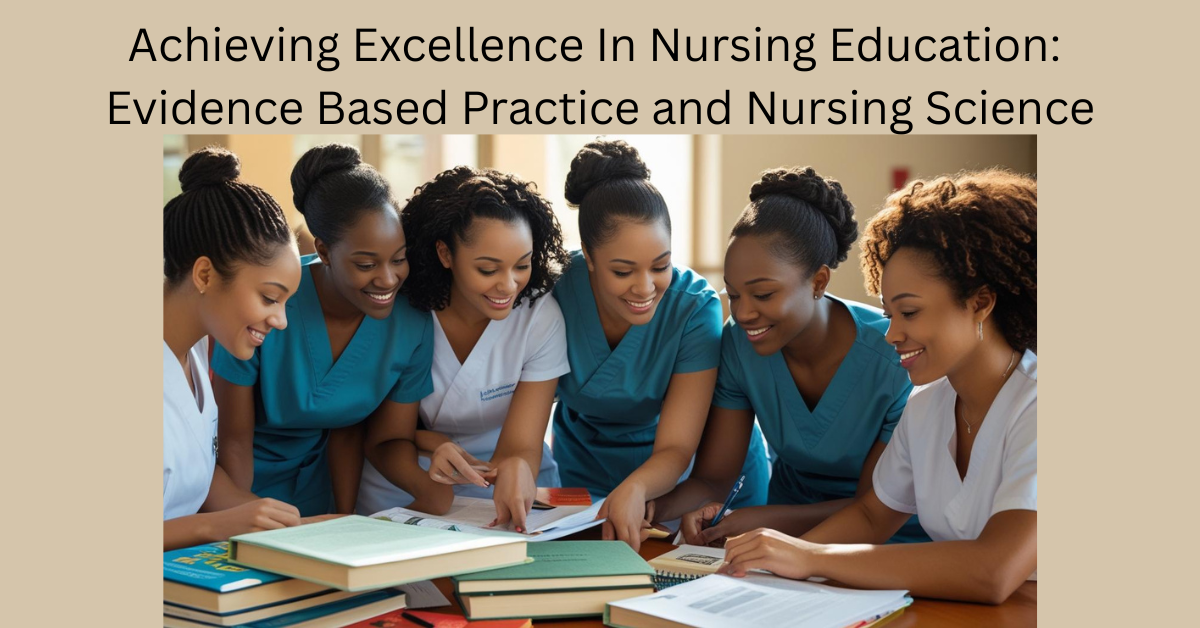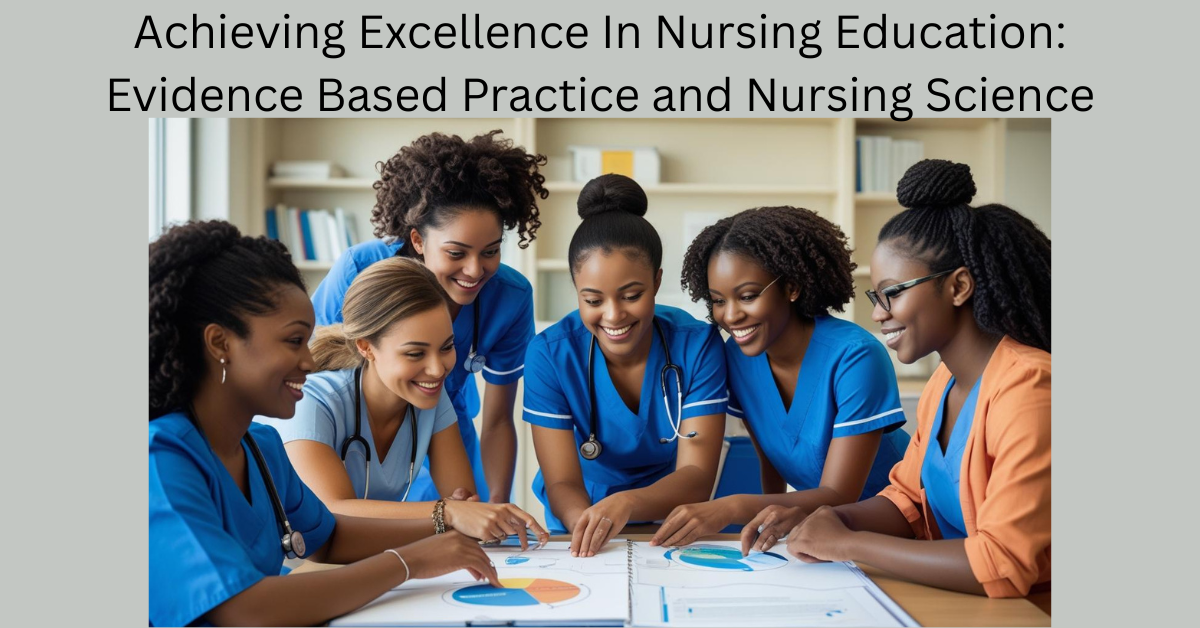Nursing education Achieving Excellence In Nursing Education Evidence Based Practice and Nursing Science describe the current affairs and innovations in health care settings.
Evidence Based Practice and Nursing Science: Achieving Excellence In Nursing Education
What is Evidence-Based Nursing Education and the Science of Nursing Education
Nurses are becoming more knowledgeable about the concept of evidence-based clinical practice, and the Institute of Medicine (2003) has asserted that this is one of the concepts that must be integral to all health professions education. The National League for Nursing asserts that nursing educators must become more knowledgeable about the concept of evidence-based teaching and base their teaching practices and curriculum designs on research (NLN, 2002, 2005e).
Suggestions for Future Research. Many research questions need to be addressed if nursing education is to continue to prepare graduates who can function effectively in a practice role, advance the science of nursing and nursing education, and provide leadership to our profession. Faculty must be equipped to tackle the problems we face today so that we can create a better tomorrow.
Guided by the Priorities for Research in Nursing Education (NLN, 2003b), nursing educators must be supported in their efforts to ask important questions about teaching practices, study the most effective and efficient ways to prepare graduates for 21st century nursing practice, and disseminate such pedagogical research.
Efforts such as these are essential to building the science of nursing education, a science that will be built through the concerted efforts of faculty, graduate students preparing for a teaching role, and educators/scholars in all types of programs. Indeed, the development of one’s ability to engage in the scholarship of teaching (Boyer, 1990) must become part of the preparation and continued development of nursing faculty.
Technology in Nursing Education
The rapid technological advances of the past 25 years have been truly remarkable, as evidenced by how the Internet and the World Wide Web have changed the health-care arena and the educational environment. The pace of technological change will continue to advance at an ever increasing rate, and the kind of technology that becomes integral to our educational worlds will change dramatically. It is impossible to discuss changes in nursing education without including and integrating concomitant changes in technology.
Many of our computer-based educational products are currently tied to screens and keyboards, but advances in virtual reality are already allowing users to interact with objects and feel as though they are “virtually there.” Imagine learning anatomy and physiology by getting inside a virtual human body and exploring its structure and complex physiological interactions. Imagine placing students on a virtual hospital unit, complete with patients, staff, and equipment.
We now have patient simulators that can speak and display physiological parameters appropriate for specific conditions, and at an affordable cost. It is now possible to move a learner through a simulation, with the degree of complexity and fidelity increasing as the learner’s knowledge and skills increase. Students can begin by managing a fairly simple patient, with a limited number of variables present and, as they progress, be assigned to manage a patient whose condition changes unexpectedly and presents them with additional data, some relevant and some irrelevant.
Once students have achieved proficiency with one dynamic, evolving patient simulation, they can be challenged to manage the care of two patients, and then an entire group of patients, for whom they must prioritize, delegate responsibility to others on the team, and assess progress. In order to create more complex and dynamic patient simulations, however, faculty must be able to set up and manage those patient scenarios.
Findings from educational research studies could provide faculty with the information they need to direct commercial companies to preprogram hundreds of patients. Faculty could then select a nursing care problem from that list, and the humanoid (ie, simulator) would exhibit signs and symptoms of the problem, requiring students to make appropriate decisions to manage it or manage the complications that arise if the initial problem is not addressed appropriately or efficiently.
To carry this future even one step further, the computer would analyze the patient care interventions of an individual student and those of the group as a whole, select the next simulated experience that advances all learners to a more challenging problem, or present a new situation that is tailored to the learning style and meets the individual learning needs of each student.
All of this is most exciting. But while technology has the potential to assist faculty and students in the teaching/leaning process, it is not the answer to all of our educational problems. Students need to be exposed to a wide range of ideas and concepts that will help them develop the knowledge, skills, and values needed to engage in nursing practice, help them manage an increasingly complex and chaotic world, spark their personal interests, cultivate their individual talents, and sow the love of learning and leadership that help our profession to grow.
Preparation for and Continued Development in the Faculty Role
The NLN began its work on exploring the preparation of nurse educators for today and the future by convening a think tank on graduate preparation for the nurse educator role to clearly define the knowledge and skills that nurse educators need.
Think Tank
Members of the think tank included faculty and administrators from all types of nursing education programs, as well as representatives from staff development and the general higher education community. One outcome of this meeting was NLN’s Position Statement on the Preparation of Nurse Educators (NLN, 2002), which states, in part, that: In light of the looming crisis in the supply of faculty to teach in schools of nursing, the time has come for the nursing profession to outline a preferred future for the preparation of nurse educators.
This crisis must be used as an opportunity to recruit qualified individuals to the educator role, to ensure that these individuals are appropriately prepared for the responsibilities they will assume as faculty and staff development educators, and to implement strategies that will serve to retain a qualified nurse educator workforce. The position statement concluded with a set of recommendations for faculty, administrators, and program development.
They proposed actions such as early identification of talented neophytes; mentoring novice faculty; reinstating the educator track in master’s programs, including learning experiences related to teaching and learning in all doctoral programs; finding innovative ways to use retired faculty; supporting faculty development; and rewarding expert educators. A second outcome of the think tank was a preliminary list of core competencies for nursing educators.
Core Competencies of The National League for Nursing Perspective
The list of core competencies developed by think tank participants was given to a Task Group on Nurse Educator Competencies, which operated under the guidance of NLN’s Nursing Education Workforce Development Advisory Council. This group of nursing educators conducted an extensive search of the literature to determine if the eight competencies identified by the think tank participants were documented in evidence-based literature, or if there was a need to modify them.
They worked for 2 years on this task and disseminated their work to the broad nursing educator community for comment. Based on this feedback, the task group refined the competencies and produced a manuscript, currently in press, that documents core competencies from the literature, identifies gaps in the literature, and proposes research questions that need to be addressed.
The Core Competencies of Nurse Educators (NLN, 2005a) have been incorporated into the Scope of Practice for Academic Nurse Educators (NLN, 2005d), and already are being used to provide direction for the development of graduate programs that prepare nursing educators.
They provide a framework of essential knowledge, skills, and attitudes relevant to the educator role. In addition, they formed the basis for the development of the first and only certification program for academic nursing educators by providing the foundation for the items that were included in the practice analysis, an essential first step in the creation of a certification examination.
Development of the Academic Nurse Educator Certification Program Certification in any field is a mark of professionalism. For academic nursing educators, it establishes nursing education as a specialty area of practice and an advanced practice role within professional nursing.
It recognizes the academic nurse educator’s specialized knowledge, skills, and abilities, and creates a means for faculty members to demonstrate their expertise in this role. Finally, it communicates to students, peers, and the higher education community that the highest standards of excellence are being met. To begin the process of developing a certification program, members of the Certification Test Development Committee created task statements for each competency in order to create a practice analysis survey.
A random sample of nursing educators was invited to complete this survey, and statistical analyzes of the results determined the blueprint for the certification examination. Another group of nursing educators created and approved all test items, and a governance committee established the policies and procedures pertinent to certification. Two hundred and six nurse educators took the pilot examination in September of 2005; 174 of them were the first to append the letters CNECM as their credential and mark of distinction.
Summary
Nursing education has been mired in old paradigms of teaching and learning for too many years, and the time is right to move out of that morass. We need to ask serious questions about the kinds of educational experiences we design for our students and whether those experiences prepare them to practice in the health-care systems of today and tomorrow. Only a research-based approach designed to create and continually refine a science of nursing education will challenge existing practices, such as the following:
- Lock-step curricula that allow for few student choices or exploration of areas of interest.
- Content-driven curricula that emphasize content coverage more than student learning.
- Teacher-centered as opposed to learner-centered approaches to nursing education.
- Specific days, hours, and locations for clinical experiences that provide little opportunity for students to experience the continuum of care.
- Evaluation and assessment practices that focus primarily on cognitive gains, objective measures, and passing the licensing exam.
Read More:
https://nurseseducator.com/high-fidelity-simulation-use-in-nursing-education/
First NCLEX Exam Center In Pakistan From Lahore (Mall of Lahore) to the Global Nursing
Categories of Journals: W, X, Y and Z Category Journal In Nursing Education
AI in Healthcare Content Creation: A Double-Edged Sword and Scary
Social Links:
https://www.facebook.com/nurseseducator/
https://www.instagram.com/nurseseducator/



